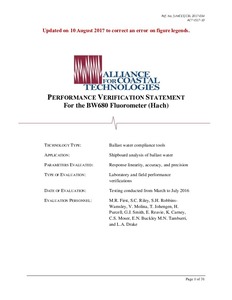| dc.contributor.author | First, M.R. | |
| dc.contributor.author | Riley, S.C. | |
| dc.contributor.author | Robbins-Wamsley, S.H. | |
| dc.contributor.author | Molina, V. | |
| dc.contributor.author | Johengen, T. | |
| dc.contributor.author | Purcell, H. | |
| dc.contributor.author | Smith, G.J. | |
| dc.contributor.author | Reavie, E. | |
| dc.contributor.author | Carney, K. | |
| dc.contributor.author | Moser, C.S. | |
| dc.contributor.author | Buckley, E.N. | |
| dc.contributor.author | Tamburri, M.N. | |
| dc.contributor.author | Drake, L.A. | |
| dc.date.accessioned | 2019-01-16T19:24:49Z | |
| dc.date.available | 2019-01-16T19:24:49Z | |
| dc.date.issued | 2017 | |
| dc.identifier.citation | First, M.R.; Riley, S.C.; Robbins-Wamsley, S.H.; Molina, V.; Johengen, T.; Purcell, H.; Smith, G.J. Reavie, E.; Carney, K.; Moser, CS.; Buckley, E.N.; Tamburri, M.N. and Drake, L.A. (2017) Performance Verification Statement
For the BW680 Fluorometer (Hach). Solomons, MD, Alliance for Coastal Technologies, 31pp. (ACT VS17-10). DOI: http://dx.doi.org/10.25607/OBP-292 | en_US |
| dc.identifier.other | [UMCES] CBL 2017-034 | |
| dc.identifier.uri | http://hdl.handle.net/11329/735 | |
| dc.identifier.uri | http://dx.doi.org/10.25607/OBP-292 | |
| dc.description.abstract | In an effort to mitigate the risk of transporting aquatic nuisance species, the United States Coast
Guard (USCG) has finalized a rule limiting the concentrations of organisms in ships’ ballast
water discharged into US ports (US Coast Guard 2012). The specified concentrations are nearly
identical (with the exception of not including limits for Vibrio cholerae in zooplankton samples)
to those in the International Maritime Organization’s (IMO) convention (IMO 2004). Further,
the limits are consistent with those in the US Environmental Protection Agency’s Vessel General
Permit (VGP)—regulations on a suite of vessel operations, including the discharge of ballast
water (US EPA 2013). In order to meet these limits, most ships will use a ballast water
management system (BWMS). These systems incorporate a variety of technologies (including
filtration, UV radiation, electrolytic chlorination, and deoxygenation) to ensure that the discharge
water meets the specifications.
Determining concentrations of living organisms can require extensive effort and sensitive
equipment, especially for sparse populations. For example, direct counts of living organisms
≥10 and <50 µm according to the method stipulated in the US Environmental Technology
Verification (ETV) Program Protocol for land-based testing of BWMS requires (1) labeling
organisms within a sample with a set of vital fluorophores and (2) tallying the organisms via
epifluorescence microscopy (EPA 2010; Steinberg et al. 2011). Direct counts of living
organisms yield concentrations comparable to the numerical standard. While this rigorous,
complex, and time-consuming analysis is appropriate for verification testing of BWMS, it is
typically not feasible to perform this analysis during routine shipboard inspections. Rather,
simple, hand-held, field instruments (“compliance tools”)—with the ability to rapidly assess that
the ballast water clearly exceeds the discharge limits—will be of much greater value to the ship
owner, the BWMS vendor, and the compliance officer. Compliance tools should immediately
produce results that are reliable indicators of the concentrations of living organisms within a
regulated size class and predict whether a sample meets or exceeds the discharge standard.
New or refined compliance tools require carefully considered test protocols for evaluating and
verifying their performance. The overall goal of this technology verification was to evaluate the
performance of potential compliance tools designed to rapidly assess ballast water discharge.
The outputs of the compliance tools were compared to the standard, validated approach (i.e.
epifluorescence microscopy; EPA 2010) used to quantify organisms ≥10 and <50 µm in size
during verification testing of BWMS. The objectives outlined below support this goal:
• In a series of laboratory trials to be conducted at the Naval Research Laboratory in Key
West, FL (NRL), determine linearity, precision and accuracy of the compliance tool
with samples of algal monocultures over a range of concentrations, including
concentrations below, equal to, and above the IMO and US discharge standard.
• Evaluate the relationship between numerical concentrations of living organisms ≥10 and
<50 µm and the accuracy and precision of the instrument using ambient organismscollected from natural waters at three various locations (Key West, Chesapeake Bay, and
Lake Superior). | en_US |
| dc.language.iso | en | en_US |
| dc.publisher | Alliance for Coastal Technologies (ACT) | en_US |
| dc.relation.ispartofseries | ACT VS; 17-10 | |
| dc.rights | CC0 1.0 Universal | * |
| dc.rights.uri | http://creativecommons.org/publicdomain/zero/1.0/ | * |
| dc.title | Performance Verification Statement for the BW680 Fluorometer (Hach). | en_US |
| dc.type | Report | en_US |
| dc.description.status | Published | en_US |
| dc.format.pages | 31pp. | en_US |
| dc.description.refereed | Refereed | en_US |
| dc.publisher.place | Solomons, MD | en_US |
| dc.subject.parameterDiscipline | Biogeochemistry | en_US |
| dc.description.currentstatus | Current | en_US |
| dc.description.eov | Zooplankton biomass and diversity | en_US |
| dc.description.bptype | Best Practice | en_US |
| dc.description.bptype | Standard Operating Procedure | en_US |
| obps.contact.contactemail | info@act-us.info | |
| obps.resourceurl.publisher | http://www.act-us.info/evaluations.php | en_US |
 Repository of community practices in Ocean Research, Applications and Data/Information Management
Repository of community practices in Ocean Research, Applications and Data/Information Management

